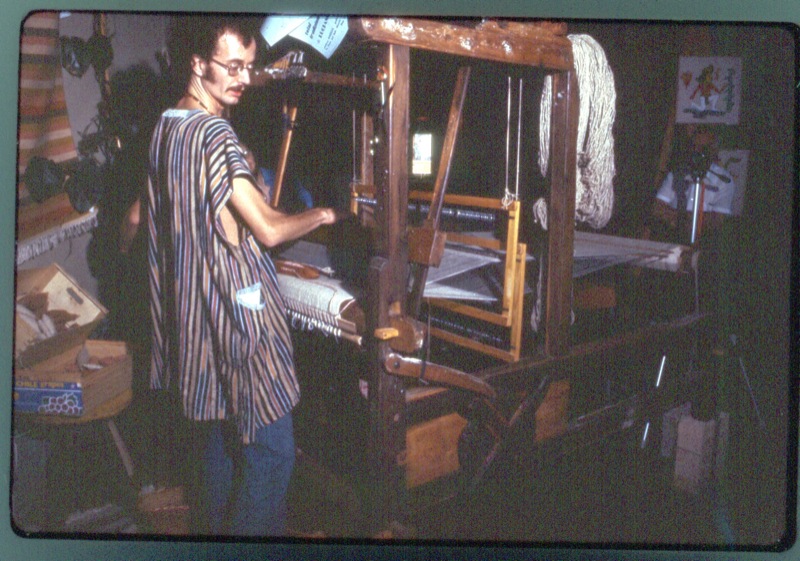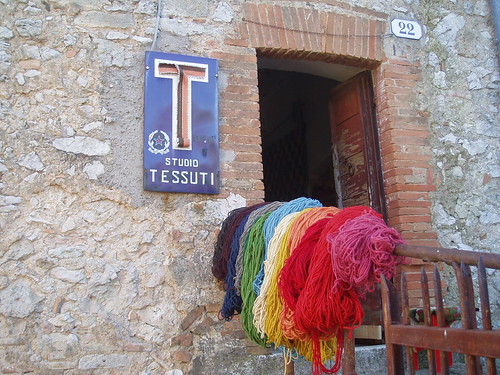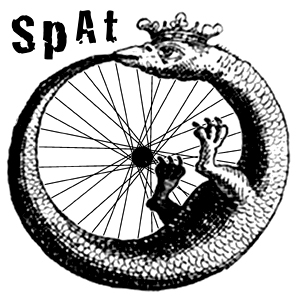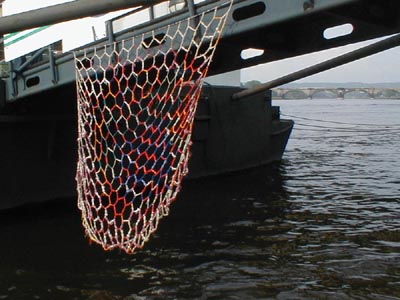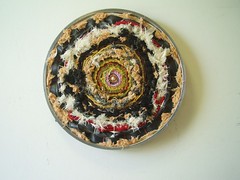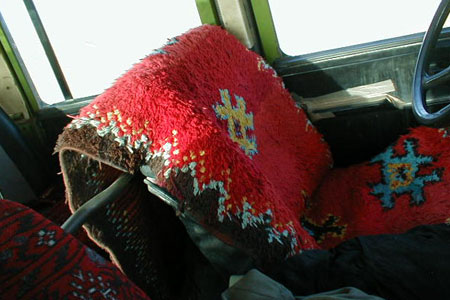 ICOC 07, Istanbul
ICOC 07, IstanbulLuciano Ghersi - Italy
Reality and politics in the Saharawi carpets
Go to PHOTO ALBUM
.
I had been appointed as a weaving teacher in a cooperation project entitled "Recovery and Development of the Traditional Saharawi Weaving" that involved Saharawi refugee women in Algeria. I here relate my brief research and my short experiments in the field.
The project lasted two weeks and was held at the Women’s Workshop of the National Union of Saharawi Women in Dajla during the months of November and December 2005.
The project was managed by the Tuscany Region (Italy) and various other partners amongst them the
“Coordinamento Tessitori e Tessimili” the Italian association of hand weavers and similar, of which I am a member.
.
The Saharawi and their weaving.
"Saharawi " is the recent name for people living in the area of the former Western Spanish Sahara, and in bordering countries such as the Canary Islands and Spain. The Saharawi people are composed of several tribes of Berbers that anciently mixed with the Maqil Bedouins from Yemen. They all speak the Hassani language, which is the same Arabic dialect spoken in Mauritania.
Contrary to Morocco’s claim of its’ ancient sovereignty regarding the territory inhabited by the Saharawi, they retort that the Almoravid Empire, which extended from Africa to Spain, was ruled by a Saharawi dynasty.
In 1975, Spain left the Western Sahara colony that was subsequently occupied and annexed by Morocco even though the Polisario Front (People’s Front for the Liberation of Saguia el-Hamra and Río de Oro) put up quite a resistance. A mass exodus of refugees towards Algeria followed.
About 250.000 Saharawi are today still living in Refugee Camps in the worst desert of Algeria, under the authority of the exiled government of RASD (Democratic Saharawi Arab Republic). I was personally able to view various rugs belonging to families and institutions, during my visit to the Festival of Saharawi People’s Culture, set up as a campsite with dozens of traditional tents.
.
In my humble opinion, no Saharawi tribal weaving may be ascertained, apart the weaving of "
Khaima", the Saharawi nomad tent.
.
In fact, they don’t even breed sheep for wool (for carpets); instead they breed only goats and camels for "Luvar", that means the tent clothe. This later wool is used exclusively for the Khaima and its related ropes. By the way, the darning on those Khaimas are modest and impressive performances of fiber art.
I later learned that darning is a job assigned to men, in other nomad tribes in the Maghreb. I would really like to know which gender does the darning amongst the Saharawi…as a male weaver I frequently stumble upon the commonplace idea that “the weaving arts are typically feminine”.
.
"Zarbiya" is the most common type of knotted rug. It is greatly inspired by the "Rabati" carpets, which are produced throughout the Maghreb. These carpets in turn have been inspired by imported Ottoman patterns/designs. The Saharawi Zarbiya has large flat woven ends.
"Gkhtifa" is also often found. It is plain red knotted with brown saw sides, that are flat woven with goat wool. This seems the pure style of the traditional "Gkhtifa" of Rehamna (Moroccan area west of Marrakech). The Saharawi Gkhtifa has large flat woven ends.
"Ushada" means cushion. Some of them are quite appealing and recall, "free weaves" from Tribal Morocco.
Paul Vandenbroek in "Azetta, L'art des femmes Berbères" notices that in the less important pieces more creative liberty is allowed.
.
I did not look into the origins of other woven objects because my course dealt with knotted rugs. However I found that:
"Hambal", which is woven partly pile & partly flat, with kilim effects. It can include patterns of Rabati origin and/or intriguing abstract naïf patterns/designs of the tribal kind.
"Tarkiya" is a blanket or striped carpet with sections decorated in “reps” or with discontinuus weft or with serial brocaded patterns. I was able to see these types of carpets being sold at the “Crièe Berbère” auction at the souk in Marrakech.
I did not find any piece older than 1975. This was due to the fact that people escaping from the war, were not able to carry any heavy family textiles with them. Therefore, the pieces I was able to observe were mainly woven inside the workshops created by the Government of the exiled RASD. These weaving centers were created mainly to allow the refugee women to interact amongst themselves, and to give them an occupation. Iron looms from Algeria were recycled for this purpose.
Some women had previously weft in the Rabati style, currently appointed to urban workshops in Dakhla and other towns of the past late Spanish Western Sahara. These were towns settled by fishermen, craft-men and traders, obviously never by farmers or nomads. Other women had never weft before their exile. The directors of the refugee workshops were people that had had a higher education; this meant that they usually gave no freedom to weavers regarding the design of the carpets. These directors were probably also foreign teachers, graduated in Fine or Decorative Arts...this is the world’s way to abolish tradition (if any) of weaving and to oppress the spontaneous creativity in the weavers that are often regarded as mere executers.
Today in these centers what prevails most are small “souvenir” pieces with political-touristy design. They are either “flat” and “pile” woven and are made with any type of knitwear fiber that is donated from industrial stock leftovers. Some women also weave at home on wood looms, on commission or for family usage.
The carpets woven in the Refugee workshops were given as diplomatic gifts to foreign allies of the RASD and to local institutions, more than just traded or for family use.
It was a quite peculiar way of spreading the carpets that was ancient and modern at the same time. This also displayed the peculiarity of the RASD that mixes an exquisite Bedouin etiquette with global politics.
The social and political meetings (called “actividades” by leaders educated and trained in Cuba) took place in tents or rooms filled with wall-to-wall carpets.
.
The Present Situation.
This social way of "spreading carpets" languished after the fall of the Socialist Block in 1989.
The warehouses of the weaving centers in the refugee camps are bulging with carpets. The women continue producing these carpets, just to keep busy. By the way, the same thing happens in the occupational centers for the
handicapped where I have often worked in Italy as a weaving teacher.
Today, some cooperation programs (funded by EU, Red Cross etc.) aim to develop the Saharawi weaving by involving it into the fair trade network. Unexpectedly, I myself was appointed in one such project. I never claimed to be an expert of pile rugs but I have designed and weft tapestries, kilim and clothe for the past 25 years. Furthermore I have collaborated with
Tamil weavers in India, Udu Dumbara weavers in Sri Lanka, and Ewe weavers in Ghana. In the end, it wasn’t written anywhere in the program that it was necessary to weave knotted rugs. It was enough to simply work at developing sellable prototypes for the fair trade market. Since I didn’t think that the knotted rug would have been successful, I proposed to adopt the “drag loom” used in
Kente weaving of Ghana. It would have been a quick and versatile loom that could have been easily built in the camp. However I encountered some resistance on the part of the proud Saharawi leaders in Italy. They believed my proposal to be a hostile attack on their national tradition. I had my doubts about their national tradition, as stated before. Therefore I studied the tied knot carpet technique in order to apply it to cushions and bags. These were less costly to produce and perhaps more sellable in the fair trade niche market.
.
My workshop course.
It's now clear, that when I landed in Algeria, I was completely in the darkness about the history of the Saharawi weaving. This can happen to any technician or cooperators in various development projects regarding hand weaving. I had tried my best, however I could not find a single Saharawi carpet documented in any book or magazine. I searched the Internet and amongst the hundreds of thousands of pages dedicated to the Saharawi, all I found was the generic phrase “they weave”…yes, but what?
I had to improvise my weaving course. I gave some pencils to my women "students", and the task to design anything for a small pile carpet, that would then be assembled into a cushion. They had never designed before, and they probably took some inspiration from their beloved henna tattooing. I selected some
scraps and encouraged the authors to weave something that might be similar to their project.
Besides the technique, that was often scanty, they weft some true masterpieces. One
piece was even selected for the international biennial exhibition "Fiber Art al Centro" held in Amelia-Italy, in 2006.
The task of drawing their ideas was a mere excuse to make them understand that I expected them to truly make a creative effort and that I wasn’t solely interested in the execution of the works. The most interesting drawings went onto become weft. Other students wove very elastic
patterns (
more). These were patterns that I had expressly studied in order to force them to continuously choose forms and colors, therefore provoking their artistic compositional capability. I would encourage them to asymmetrically disseminate the back of the textile with different
executions of the floral designs that they already knew well enough.
In the beginning, they felt puzzled and were afraid of making mistakes in the set drawing: they didn’t really understand what it would be… because there was no “precise drawing”! As they carried on with their work, they gained confidence and took their expressive liberties, sometimes
excellently. This is not surprising, because weaving is a popular, spontaneous, and universal art, above all amongst women and not solely.
.
"The Future".
The biggest and the oldest weaving center of the Saharawi refugees is in the city of “27th February” (the Saharawi Independence Day). Located in this city is the Cooperative “El Futuro” (the Future), which has 24 large looms.
The renovation and development of this weaving center are being overseen by a cooperation project managed by the Calabria Region (Italy).
The historical
emblem of “El Futuro” deserves our attention: it shows an arm and a leg crossed. The arm is clasping a comb that beats the weft. But what does the leg have to do with it? One doesn’t use their leg for weaving! The leg has wedged its way into the emblem to give importance to the weavers’ chronic leg pains.
Normally each woman would sit comfortably on the ground with her legs crossed. They can put a cushion under their knees, or a ball of trhread when they are sitting and working at the loom. However, the looms at “El Futuro” weren’t made to be used while sitting on the floor. The weavers needed a pretty high bench to be able to weave.
In the most ancient of carpet looms the yarn warp is taut to the ground between two posts, which are fastened to stakes. The weavers sit on the same carpet they are weaving. Even weavers that work on vertical looms weave in this manner (by sitting on the ground) and have the textile go down as it gradually takes form.
The looms, which need a bench to work on, obviously come from Chair-Land: Europe. Indeed, halfway through the 18th century, France had started to use the local textile labor force in its’ North African colonies. These “modern” bench looms, with their iron devices, quickly became widely used. Or perhaps the bench looms arrived later, with the arrival of Art Institutes or with International Aid. I, as a weaver would simply modify all looms that make a person suffer.
I was invited by the Italian board to keep in charge also the "El Futuro" project. However I have the clear impression that I will be excluded.
______
Go to PHOTO ALBUM______
I have also created a
Web site where you can thoroughly look into the subject of this panel.
Unfortunately it is in Italian only, with some parts in Spanish, however there is a gallery full of images.
